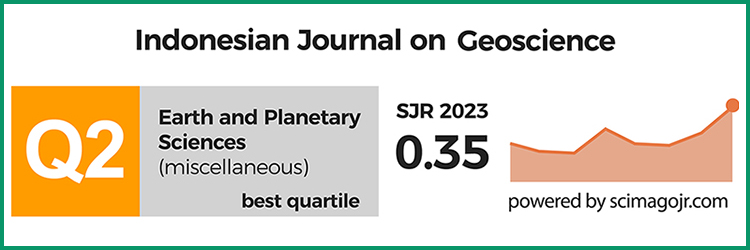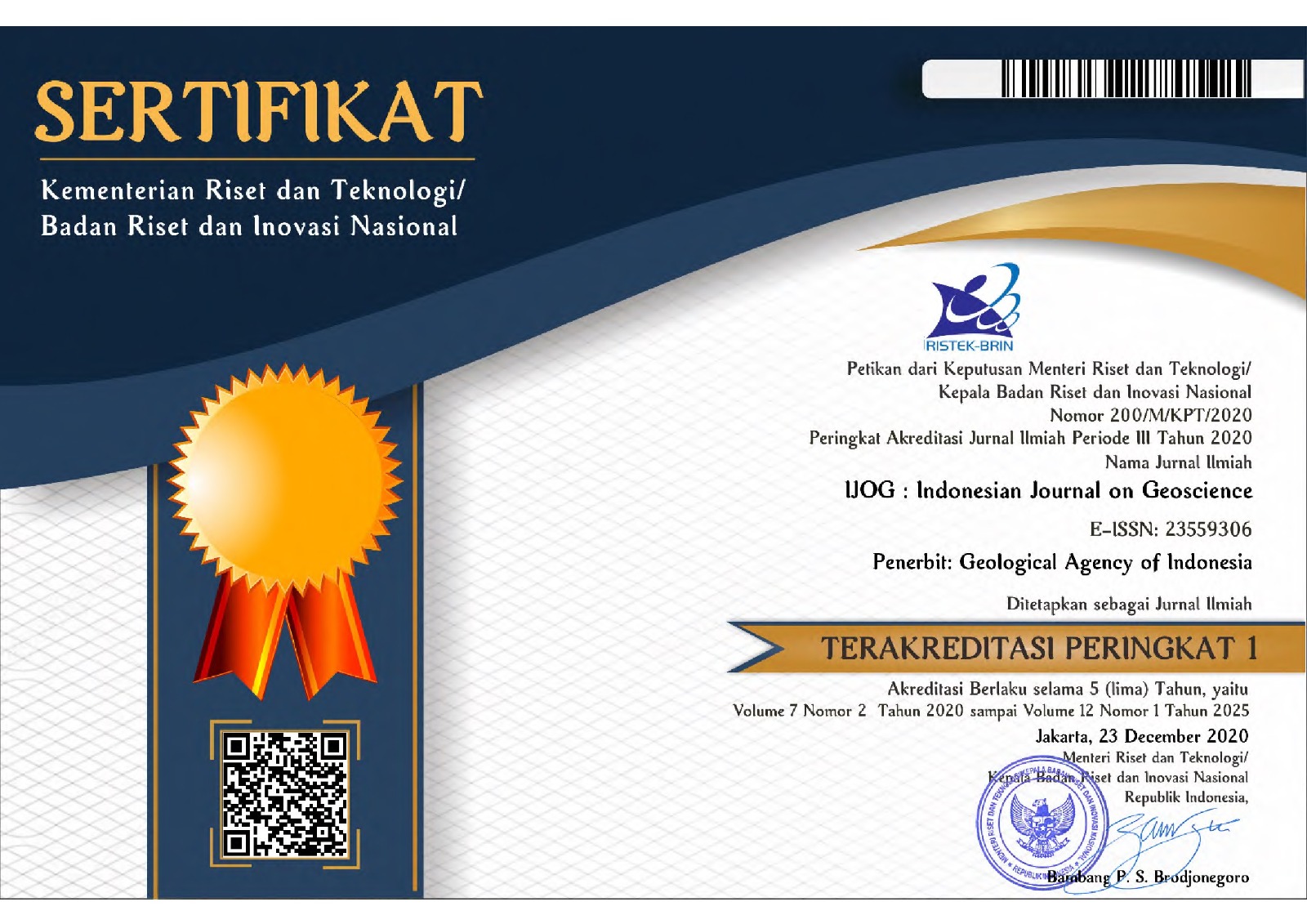Emergence of Lava Dome from the Crater Lake of Kelud Volcano, East Java
DOI:
https://doi.org/10.17014/ijog.4.4.229-238Keywords:
Kelud Volcano, crater lake, seismic activity, VT earthquakes, lava domeAbstract
Kelud Volcano (+1731 m) in East Java is one of the most active and dangerous volcanoes in Indonesia. A large lake occupies the summit crater. Historical eruptions generally only lasted for a very short time, mostly no longer than a few hours. The outburst is usually accompanied by pyroclastic flows. On August 2007, the activity of the volcano was initiated by the increase of the temperature of lake water and the change of the colour from typical green to yellow. Activities of the volcano are discussed following the swarms of volcano-tectonic (VT) earthquakes on September 10th, September 26th to 29th, and October 24th to November 2nd. On September 26th to 29th, hypocentral distribution of those VT shifted from 5 km deep to just beneath the crater. The highest number of VT earthquakes occurred on November 1st attaining 50 events, then followed by a swarm of B-type events, where the number reached 1437 events in a day. The volcanic activity peaked on November 3rd when seismic records became saturated, which then was preceded by a sharp increase of lake temperature and a sudden deflation of radial tilt. It suggests that the lava extrusion forming a lava dome was taking place.
References
Hidayati, S., Iguchi, M., Ishihara, K., Purbawinata, M.A., Subandriyo, Sinulingga, I.K., and Suharna, 1998. A preliminary result of quantitative evaluation on activity of Merapi volcano. Proccedings On Symposium on Japan - Indonesia IDNDR Project, p. 165 - 180.
Hidayati, S., Ishihara., K., and Iguchi, M., 2007. Volcano-tectonic Earthquakes during the Stage of Magma Accumulation at the Aira Caldera, Southern Kyushu, Japan. Bulletin Volcanological Society of Japan, 52 (6), p.289-309.
Iguchi. M., 1994. A vertical expansion source model for the mechanisms of earthquakes originated in the magma conduit of an andesitic volcano: Sakurajima, Japan. Bulletin Volcanological Society of Japan, 39, p.49-67.
Ishihara, K., 1990. Pressure sources and induces ground deformation associated with explosive eruptions at andesitic volcano: Sakurajima volcano, Japan. In: Ryan, M.P. (Ed.), Magma Transport and Storage, John Willey & Sons, Chischester, p.335 - 356
Kamo, K., 1978. Some phenomena before the summit eruptions at Sakurajima volcano. Bulletin Volcanological Society of Japan, 23, p.53-64. (In Japanese with English abstract)
Kunrat, S.L, 2009. Geochemical and Thermodynamic Modeling of Volcanic Fluids and Their Interpretation for Volcano Monitoring. Université Libre de Bruxelles (unpublished paper).
Kusumadinata, K., 1979. Data Dasar Gunungapi Indonesia. Direktorat Vulkanologi, Bandung.
Latter, J.H., 1981. Volcanic earthquakes and their relationship to eruptions at Ruapehu and Ngauruhoe volcanoes. Journal of Volcanology and Geothermal Research, 9, p.293 - 309.
Lesage, Ph. and Surono, 1995. Seismic precursors of the February 10, 1990 eruption of Kelut volcano, Java. Journal of Volcanology and Geothermal Research, 65, p. 135-146.
Minakami, T. 1974. Seismology and volcanoes in Japan. In: Civetta, L., Gasfarini, P., Luongo, G., and Rapolla, A. (Eds.), Physical Volcanology, p.1 - 27. Elsevier.
Nishi, K., 1984. Volcanic B-type earthquake swarm preceding volcanic explosion. Annual Disaster Prevention Research Institute, Kyoto University, 27B-1, p.29-34. (In Japanese with English abstract).
Nishi, K., 2005. Graphical Hypocentre Calcuation software (GrHypo).
Ratdomopurbo, 1995. Etude sismoloique du Vulcan Merapi et formation du dome de 1994. PhD thesis, L’universite Joseph Fourier-Grenoble I, France, Unpublished.
Zaennudin, A. and Budianto, A., 2009. Prakiraan Bahaya Erupsi G. Kelud (unpublished report).



















